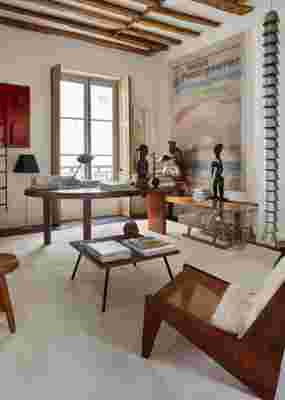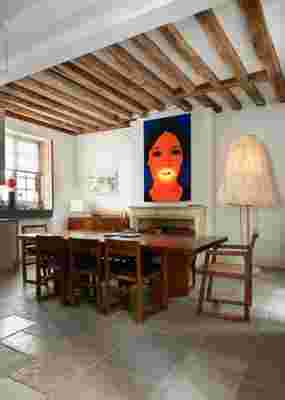Although now front and center at art fairs, auctions, and shelter publications, the works of such midcentury masters as Charlotte Perriand, Le Corbusier, and Jean Prouvé were less broadly known in the early 1980s. When French art dealer François Laffanour founded his Paris design outpost, Galerie Downtown, in 1980, he was one of the first to take a serious look at furniture created by leading architects from the era.
Asked how he imbued this prescient aesthetic throughout his Left Bank residence, Laffanour naturally starts at the beginning. “I am an art dealer specializing in architects' furniture," he says, noting that his main interests are in the work of Charlotte Perriand and Jean Prouvé. "In terms of business, I started with 1950s furniture and very quickly found an inventory of Prouvé pieces.” At the same time he was starting his firm, Laffanour was also beginning to collect art for himself, a passion which continues to this day. “Art is bought when I have the opportunity," he says, mentioning an early and immediate affinity for the work of Takis, which continues to this day. "I feel comfortable living with his work, like a security blanket," he says.

In Laffanour's second-floor office, the desk is a table by Charlotte Perriand, and other works are by Jean-Pierre Reynaud, Mungo Thomson, Joseph Beuys, Pierre Jeanneret, and Ronan and Erwan Bouroullec.
Laffanour's collection—which comprises yet more pieces by Ettore Sottsass, Pierre Chareau, Serge Mouille, Diego Giacometti, Martin Borowski, and Josef Hoffmann, among others—lines every floor of his charming house. Arriving at his home, one walks through a street-side door to a wonderful garden, terraced dining area, and just beyond, a four-story edifice. “It was a kind of a dream," he says of finding the property five years ago. "When I was a student I was always dreaming of a nice place in Saint Germain, [with] these trees behind closed doors.”
The ultimate resource for design industry professionals, brought to you by the editors of Architectural Digest

The previous owner, who occupied the space for some two decades, had done little in terms of updating, so everything had to be redone before Laffanour moved in. Each floor—approximately 645 square feet, with two rooms—accesses a central staircase. “It’s like an English mews house, always going up and down,” laughs Laffanour, who lives here with his wife, Alexandra, a musician, and occasionally two grown kids when they come home. Wanting to retain the original patinated feel of the building, they installed parquet de Versailles floors, which were burnt and then oiled. They also added indoor shutters in lieu of curtains. All told, the restoration took about eight months.

Reflecting on his domestic lifestyle, Laffanour says that his routine is all about being surrounded by his beloved art and objects, the things he collects and discovers. But he says he is also constantly asking himself other, more forward-looking questions. “What is modernity?" he ponders. "Today I am focused on going a bit deeper into the spirit of creation, not just showing the pieces—I want a new generation to look at things with a new spirit.” Mission accomplished.
